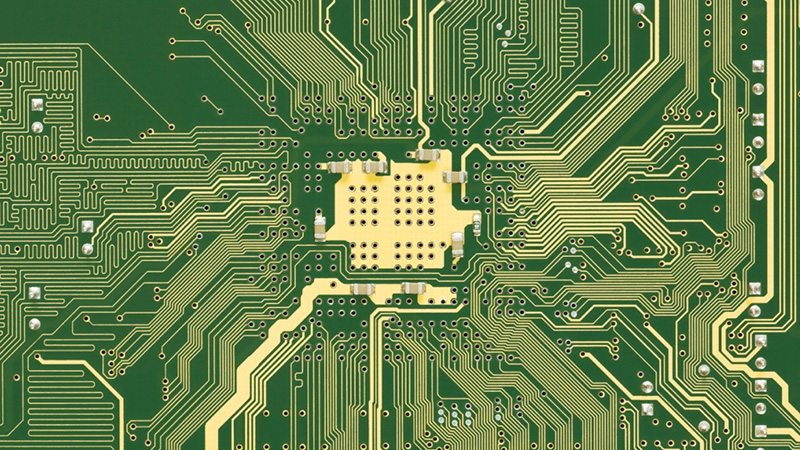
High-frequency and high-speed PCB design
1. After the PCB design is completed, how to choose the PCB board?
The choice of PCB board must strike a balance between meeting the design requirements, mass production and cost. Design requirements contain both electrical and mechanical components. Usually this material issue is more important when designing very high-speed PCB boards (frequency greater than GHz). For example, the FR-4 material that is commonly used today may not be suitable for the dielectric loss (dielectric loss) at a frequency of several GHz, which will have a great impact on signal attenuation. As far as electricity is concerned, it is necessary to pay attention to whether the dielectric constant (dielectric constant) and dielectric loss are suitable for the designed frequency.
2. How to avoid high frequency interference?
The basic idea of avoiding high-frequency interference is to minimize the interference of high-frequency signal electromagnetic fields, which is the so-called crosstalk (Crosstalk). You can increase the distance between the high-speed signal and the analog signal, or add ground guard/shunt traces next to the analog signal. Also pay attention to the noise interference of the digital ground to the analog ground.
3. In high-speed PCB design, how to solve the signal integrity problem?
Signal integrity is basically a matter of impedance matching. Factors affecting impedance matching include signal source architecture and output impedance, characteristic impedance of traces, characteristics of load terminals, topology architecture of traces, and so on. The solution is to rely on termination and adjust the topology of the wiring.
4. How is the differential distribution method realized?
There are two points to pay attention to in the wiring of the differential pair. One is that the length of the two lines should be as long as possible, and the other is that the distance between the two lines (this distance is determined by the differential impedance) must always remain unchanged, that is, it must be kept parallel. There are two parallel ways, one is that the two lines run on the same wiring layer (side-by-side), and the other is that the two lines run on the upper and lower adjacent layers (over-under). Generally, the former side-by-side (side by side, side by side) is used in many ways.
5. For a clock signal line with only one output terminal, how to implement differential wiring?
To use differential wiring, it is only meaningful that the signal source and receiver are both differential signals. So it is not possible to use differential wiring for a clock signal with only one output.
6. Can a matching resistor be added between the differential line pairs at the receiving end?
The matching resistance between the differential line pairs at the receiving end is usually added, and its value should be equal to the value of the differential impedance. This way the signal quality will be better.
7. Why should the wiring of differential pairs be close and parallel?
The routing of differential pairs should be properly close and parallel. The so-called proper proximity is because the spacing will affect the value of differential impedance, which is an important parameter for designing a differential pair. The need for parallelism is also due to the need to maintain the consistency of the differential impedance. If the two lines are far or near, the differential impedance will be inconsistent, which will affect signal integrity and timing delay.
8. How to deal with some theoretical conflicts in actual wiring
Basically, it is right to separate the analog/digital ground. It should be noted that the signal traces should not cross the divided place (moat) as much as possible, and the return current path (returning current path) of the power supply and signal should not become too large.
The crystal oscillator is an analog positive feedback oscillation circuit. In order to have a stable oscillation signal, it must meet the specifications of loop gain and phase. However, the oscillation specification of this analog signal is easily disturbed, and even adding ground guard traces may not be able to completely isolate the interference. And if it is too far away, the noise on the ground plane will also affect the positive feedback oscillator circuit. Therefore, the distance between the crystal oscillator and the chip must be as close as possible.
Indeed, there are many conflicts between high-speed routing and EMI requirements. But the basic principle is that the resistors and capacitors or ferrite beads added due to EMI cannot cause some electrical characteristics of the signal to fail to meet the specifications. Therefore, it is best to use the techniques of arranging wiring and PCB stacking to solve or reduce EMI problems, such as routing high-speed signals to the inner layer. Finally, use the resistor capacitor or ferrite bead to reduce the damage to the signal.
9. How to solve the contradiction between manual wiring and automatic wiring of high-speed signals?
Most of the automatic routers of the stronger routing software now have set constraints to control the routing method and the number of vias. The setting items of winding engine capabilities and constraint conditions of various EDA companies sometimes differ greatly. For example, whether there are enough constraints to control the way the serpentine snakes, whether to control the trace spacing of the differential pairs, etc. This will affect whether the routing method obtained by automatic routing can meet the designer's idea. In addition, the difficulty of manually adjusting the wiring also has an absolute relationship with the ability of the winding engine. For example, the pushing ability of traces, the pushing ability of vias, and even the pushing ability of traces to copper, etc. Therefore, choosing a router with a strong winding engine capability is the solution.
10. About test coupons.
The test coupon is used to measure whether the characteristic impedance of the produced PCB meets the design requirements by TDR (Time Domain Reflectometer). Generally, the impedance to be controlled has two cases: a single line and a differential pair. Therefore, the line width and line spacing (when there are differential pairs) on the test coupon should be the same as the lines to be controlled. The most important thing is the position of the ground point when measuring. In order to reduce the inductance value of the ground lead (ground lead), the place where the TDR probe (probe) is grounded is usually very close to the place where the signal is measured (probe tip). Therefore, the distance and method between the point where the signal is measured on the test coupon and the ground point To match the probe used.
11. In high-speed PCB design, the blank area of the signal layer can be covered with copper, but how should the copper of multiple signal layers be distributed on grounding and power supply?
Generally, most of the copper in the blank area is grounded. Just pay attention to the distance between the copper and the signal line when depositing copper next to the high-speed signal line, because the deposited copper will reduce the characteristic impedance of the trace a little. Also be careful not to affect the characteristic impedance of other layers, such as in the structure of a dual strip line.
12. Is it possible to use the microstrip line model to calculate the characteristic impedance of the signal line above the power plane? Can the signal between power and ground plane be calculated using stripline model?
Yes, both the power plane and the ground plane must be considered as reference planes when calculating the characteristic impedance. For example, a four-layer board: top layer-power layer-ground layer-bottom layer. At this time, the model of the characteristic impedance of the top layer trace is the microstrip line model with the power plane as the reference plane.
13. In general, can automatic generation of test points by software on high-density printed boards meet the test requirements of mass production?
Whether the test points automatically generated by the general software meet the test requirements depends on whether the specifications for adding test points meet the requirements of the test equipment. In addition, if the wiring is too dense and the specification for adding test points is relatively strict, it may not be possible to automatically add test points to each segment of the line. Of course, it is necessary to manually fill in the places to be tested.
14. Will adding test points affect the quality of high-speed signals?
As for whether it will affect the signal quality, it depends on the way of adding test points and how fast the signal is. Basically, additional test points (not using the existing via or DIP pin as test points) may be added to the line or pulled out from the line. The former is equivalent to adding a small capacitor online, while the latter is an extra branch. These two situations will affect the high-speed signal more or less, and the degree of influence is related to the frequency speed of the signal and the edge rate of the signal (edge rate). The size of the impact can be known through simulation. In principle, the smaller the test point, the better (of course, it must also meet the requirements of the test equipment). The shorter the branch, the better.
15. Several PCBs form a system, how should the ground wires between the boards be connected?
When the signal or power between the interconnections of various PCB boards is in motion, for example, board A has power or signals sent to board B, there must be an equal amount of current flowing from the ground layer back to board A (this is Kirchoff current law). The current on this formation will find the place of least resistance to flow back. Therefore, the number of pins assigned to the ground plane should not be too small at each interface, no matter whether it is a power supply or a signal, so as to reduce the impedance, which can reduce the noise on the ground plane. In addition, it is also possible to analyze the entire current loop, especially the part with a large current, and adjust the connection method of the ground layer or ground wire to control the current flow (for example, create a low impedance somewhere, so that most of the current flows from this places) to reduce the impact on other more sensitive signals.
16. Can you introduce some foreign technical books and data on high-speed PCB design?
Now high-speed digital circuits are used in related fields such as communication networks and calculators. In terms of communication networks, the operating frequency of the PCB board has reached GHz, and the number of stacked layers is as many as 40 layers as far as I know. Calculator-related applications are also due to the advancement of chips. Whether it is a general PC or a server (Server), the maximum operating frequency on the board has also reached 400MHz (such as Rambus). In response to the high-speed and high-density routing requirements, the demand for blind/buried vias, mircrovias and build-up process technology is gradually increasing. These design requirements are available for mass production by manufacturers.
17. Two frequently referenced characteristic impedance formulas:
Microstrip line (microstrip) Z={87/[sqrt(Er+1.41)]}ln[5.98H/(0.8W+T)] where W is the line width, T is the copper thickness of the trace, and H is The distance from the trace to the reference plane, Er is the dielectric constant of the PCB material (dielectric constant). This formula can only be applied when 0.1<(W/H)<2.0 and 1<(Er)<15.
Stripline (stripline) Z=[60/sqrt(Er)]ln{4H/[0.67π(T+0.8W)]} where H is the distance between the two reference planes, and the trace is located in the middle of the two reference planes . This formula can only be applied when W/H<0.35 and T/H<0.25.
18. Can a ground wire be added in the middle of the differential signal line?
Generally, the ground wire cannot be added in the middle of the differential signal. Because the most important point of the application principle of differential signals is to use the benefits brought by the mutual coupling (coupling) between differential signals, such as flux cancellation, noise immunity and so on. If a ground wire is added in the middle, the coupling effect will be destroyed.
19. Does rigid-flex board design require special design software and specifications? Where in China can undertake this type of circuit board processing?
The flexible printed circuit (FPC) can be designed with general PCB design software. Also use the Gerber format to produce for FPC manufacturers. Since the manufacturing process is different from ordinary PCBs, each manufacturer will have its own requirements for the minimum line width, minimum line spacing, and minimum aperture (via) according to their manufacturing capabilities. In addition, some copper skin can be laid on the turning point of the flexible circuit board for reinforcement. As for the manufacturer of the production, it should be able to find it in the keyword search of "FPC" on the Internet.
20. What is the principle of properly selecting the grounding point of the PCB and the case?
The principle of selecting the grounding point of the PCB and the shell is to use the chassis ground to provide a low-impedance path for the return current (returning current) and control the return current path. For example, usually near the high-frequency device or the clock generator, the ground layer of the PCB can be connected with the chassis ground by fixing screws to minimize the area of the entire current loop, thereby reducing electromagnetic radiation.
21. What aspects should be started from for circuit board DEBUG?
As far as digital circuits are concerned, first determine three things in sequence: 1. Confirm that all power supply values are sized to meet the design requirements. Some systems with multiple power supplies may require certain specifications for the order and speed of certain power supplies. 2. Verify that all clock signal frequencies are working properly and there are no non-monotonic issues on the signal edges. 3. Confirm whether the reset signal meets the specification requirements. If all these are normal, the chip should send out the signal of the first cycle (cycle). Next, debug according to the system operation principle and bus protocol.

22. When the size of the circuit board is fixed, if more functions need to be accommodated in the design, it is often necessary to increase the trace density of the PCB, but this may lead to enhanced mutual interference of the traces, and at the same time, the traces are too thin to increase the impedance. It cannot be reduced, please experts introduce the skills in high-speed (>100MHz) high-density PCB design?
When designing high-speed and high-density PCBs, crosstalk interference should be paid special attention because it has a great impact on timing and signal integrity. Here are a few things to pay attention to:







